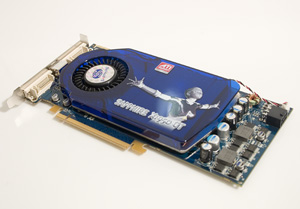Sapphire Radeon X1950 GT 256 MB
Board Design
Board Design
The Radeon X1950 GT is based on the same PCB design as the Radeon X1950 Pro, which isn't surprising, as the two boards share the same core architecture, the ATI RV570. The deep teal blue PCB is surprisingly large considering the mid-range price tag of this card, although the length should not pose any spacing issues with the majority of cases on the market. The card is based on a PCI Express x16 interface, and there have been no announcements as of yet if there will be X1950 GT AGP variants, although it's technically possible using ATI's "Rialto" PCIe to AGP bridge chip. (There are X1950 Pro AGP cards available)

|

|
The X1950 GT and Pro cards also share the same cooling unit, featuring Sapphire's robotic alien lady, which is nearly standard with all of their new products. The cooler is a single slot unit which features a large aluminum alloy base plate which connects to a set of copper thin fins. The heatsinks are cooled with an embedded (short) 60mm fan. The fan, unfortunately, is somewhat loud during normal operations, and the speed of the fan is not thermally controlled, which means it spins at its full speed all the time. If you're willing to install a third party application like RivaTuner, you can indeed control the fan speeds through Windows, although we wish ATI had included this feature natively, either in hardware or through the Catalyst Control Center software.
The board is equipped with two dual-link DVI output ports, meaning this card can power screen resolutions up to 2560 x 1600. Sandwiched in-between the DVI ports is a flexible TV output jack, which supports HDTV (Component), Composite, and S-Video output. The board does not support VIVO functionality, which means that the board can only output video, and cannot take in video streams from other sources.
The Radeon X1950 GT is the second card release (after the Radeon X1950 Pro) which supports ATI's second generation Crossfire technology. The new internal Crossfire connector can be seen at the top of the PCB near the DVI ports. This new method of Crossfire allows multi-GPU operation without an external card connector cable, which was ubiquitous with ATI's first generation Crossfire technology. In order to run two of these boards in Crossfire, you need a Crossfire compliant motherboard using an ATI chipset or Intel's 975X or P965 chipset.

|

|
The end of the PCB is covered by power conversion components, and the PCI Express power connector. The board requires a 6-pin PCI Express power cable to function.






